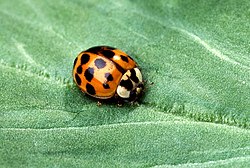| Harmonia | |
|---|---|
 | |
| Asian lady beetle, Harmonia axyridis | |
 | |
| Harmonia testudinaria | |
| Scientific classification | |
| Kingdom: | Animalia |
| Phylum: | Arthropoda |
| Class: | Insecta |
| Order: | Coleoptera |
| Suborder: | Polyphaga |
| Infraorder: | Cucujiformia |
| Family: | Coccinellidae |
| Tribe: | Coccinellini |
| Genus: | Harmonia Mulsant, 1846 |
| Synonyms | |
Harmonia is a genus of lady beetles belonging to the subfamily Coccinellinae.